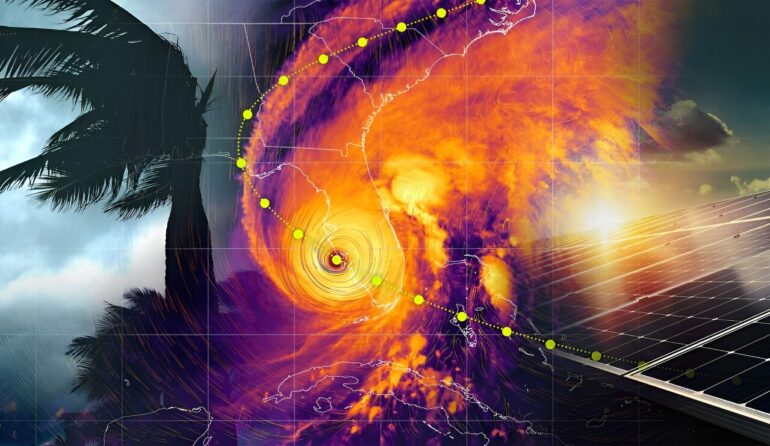When hurricanes threaten tropical shores, “super grids” could come to the rescue.
Caribbean islands are starting to shift away from importing expensive fossil fuels, using instead their own abundant sun and wind to make electricity. However, their frequent hurricanes can put a damper on solar energy generation. Researchers at the Department of Energy’s Oak Ridge National Laboratory developed a comprehensive modeling method to predict the drop in electricity generation better when these storm clouds overshadow solar panels.
The team explored ways to compensate for these energy losses with super grids, a collection of grids connected so electricity can flow across island chains or between continents.
Lead researcher Rodney Itiki said this kind of infrastructure planning is crucial to maintaining equitable access to electricity in the Caribbean’s 12 island countries and the U.S. territories of Puerto Rico and the U.S. Virgin Islands.
The historically underserved island residents can’t easily evacuate from the path of the many hurricanes that hammer the Caribbean each year. The loss of the sun’s energy during hurricanes is likely to become increasingly important on islands like Puerto Rico, which declared a goal of converting to all-renewable energy by 2050.
Itiki’s model can be used to understand the impact of hurricane clouds on any electric system. In this study, he and his team of experts in grid integration, renewables, and advanced computing methods used his algorithm to explore different grid connection approaches, modeling how each would affect the availability of electricity. The model analyzed how a large hurricane would reduce power from known solar installations while traveling 10 possible paths over 10 to 14 days.
“This is one of the major contributions of the research because when we design the power system, we need to do it considering all possible cases—most of all, the worst-case scenario,” said Itiki, a postdoctoral research associate with ORNL’s Power Systems Resilience group.
In their study published in the journal Energies, researchers used simulations to understand power availability during hurricanes if electric grids were connected via high-voltage cables on the ocean floor. To learn whether these super grids would balance energy flow among regions, the team modeled four different combinations: a standalone U.S. grid, a standalone Caribbean super grid tying all the islands together, a U.S.-Caribbean super grid, and a super grid connecting the U.S., Caribbean islands and South America.
The largest super grid configuration included 90 photovoltaic plants within the hurricane corridor, plus solar farms in places such as California and Brazil that are unaffected by these hurricanes. The model showed some solar plants losing as much as 88% of their generating capacity for two days while shaded by hurricane clouds.
Researchers found the U.S.-Caribbean super grid increases power reliability the most. The standalone Caribbean super grid proved least helpful, partly because hurricane trajectories typically align with the chain of islands. The South American addition did not significantly reduce power variations because the continent has few solar installations. However, it could provide energy security as an alternate power supply if islands became disconnected from each other or from the U.S. system.
Itiki was intrigued as a graduate student by the successful subsea link between electric grids of the United Kingdom and Germany. He studied the potential benefits of similar connections until a 2017 natural disaster narrowed his geographic focus.
“Soon after Hurricane Maria hit Puerto Rico, I started thinking about interconnecting Puerto Rico with Florida,” Itiki said. Maria left some Puerto Ricans without electricity for almost a year, the longest blackout in U.S. history.
Itiki’s first focus was wind energy during hurricanes. He explored how a U.S.-Caribbean super grid could reduce power slumps caused when hurricanes damage Puerto Rican wind turbines. After improvements to turbine technology made them stronger, he examined how a surge of hurricane wind energy could be shared among the Caribbean, the U.S., and South America.
Next, Itiki intends to fuse his solar and wind algorithms to determine how super grids could broadly enhance energy reliability in both the Caribbean and on the mainland. For example, during a major weather event in the U.S., could the Caribbean grid provide supplementary power to the U.S.?
The research has broad implications for U.S. energy independence from fossil fuels—and for reliably integrating renewable projects. “I don’t think people are planning photovoltaic [solar] plants while taking hurricane shading into account,” Itiki said. “Utilities are choosing locations with the maximum sun exposure, but they also need to consider the normal trajectory of hurricanes. If all the plants are concentrated in Florida, and a hurricane hits there, it will create a maximum power valley.”
Itiki acknowledged that further studies are needed to probe the environmental and economic viability of laying undersea cables. But even without these interconnections, Itiki’s model provides a vital new tool for estimating solar energy during extreme weather and planning transmission systems to compensate. Utilities could use the algorithm to prepare for the solar energy gap during storms, using solutions such as batteries or pumped-storage hydropower.
More information:
Rodney Itiki et al, Method for Spatiotemporal Solar Power Profile Estimation for a Proposed U.S.–Caribbean–South America Super Grid under Hurricanes, Energies (2024). DOI: 10.3390/en17071545
Provided by
Oak Ridge National Laboratory
Citation:
Study shows potential of super grids when hurricanes overshadow solar panels (2024, April 24)
